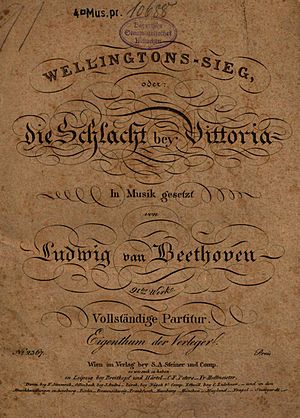Wellington's Victory facts for kids
Wellington's Victory, also known as the Battle of Vitoria or the Battle Symphony, is a famous piece of music by Ludwig van Beethoven. Its official name in German is Wellingtons Sieg oder die Schlacht bei Vittoria, Op. 91. This orchestral work, which lasts about 15 minutes, was written to celebrate a big victory.
It honors the Duke of Wellington's win over Joseph Bonaparte at the Battle of Vitoria in Spain on June 21, 1813. This battle was a key moment in the German campaign of 1813, helping to end Bonaparte's rule in Germany and leading to the creation of the German Confederation. Beethoven worked on this piece from August to October 1813, and it became very popular, earning him a lot of money. The original handwritten music is kept safe in the Berlin State Library.
Contents
What Instruments Are Used?
Wellington's Victory is quite special because of the many instruments it uses. The full group of instruments, called the orchestration, includes:
- Two flutes
- A piccolo (a small flute)
- Two oboes
- Two clarinets
- Two bassoons
- Four horns
- Six trumpets
- Three trombones
- Timpani (kettledrums)
It also has a large group of percussion instruments. These include sounds like muskets firing and artillery cannons! The usual string section is also there, with violins, violas, cellos, and double basses.
In the percussion section, one player handles the timpani. Three other players manage the cymbals, bass drum, and triangle. On the stage, there are two "sides" representing the British and French armies. Each side has two side drums, two bass drums (called "Kanone" for cannons in the music), and two (or four) ratchets. About eight to ten musicians play these instruments.
How the Music Is Structured
The music is divided into two main parts: "The Battle" (Schlacht) and "The Victory Symphony" (Sieges Sinfonie).
The Battle Part
The first part is like a musical story, also known as programme music. It describes two armies getting closer to each other and then shows scenes of the battle itself.
- For the British side, Beethoven uses the tune "Rule Britannia".
- For the French side, he uses "Malbrough s'en va-t-en guerre" ("Marlborough has left for the war"). You might know this tune today as "For He's a Jolly Good Fellow".
Beethoven might have chosen not to use "La Marseillaise" for the French, unlike Tchaikovsky in his 1812 Overture, because playing "La Marseillaise" was seen as an act of treason in Vienna at that time.
The Victory Symphony Part
The second part is more like a traditional symphony. It starts with a bright, loud musical call, called a fanfare, in the key of D major. Then, the music changes to a different key, B-flat major, for the second main tune. This second tune is "God Save the King", which was the British national anthem.
Instead of ending "God Save the King" normally, Beethoven repeats a small musical idea to switch back to the D major key. The fanfare tune then returns. After this, "God Save the King" plays again, now in the main key of D major and at a moderate, dance-like speed (like a "Tempo di menuetto moderato"). Again, the ending of the anthem is changed. This leads into a section where different instruments play the same tune one after another, like a musical chase. This part uses pieces of the "God Save the King" tune, creating a lively and complex sound. The piece finishes with more variations of the anthem's melodies, ending with a powerful and triumphant sound.
The Panharmonicon: A Special Machine
The very first version of "Wellington's Victory" was not written for a full orchestra. Mälzel, who is famous for inventing the metronome, asked Beethoven to write a short piece for his special invention called the panharmonicon. This machine was like a mechanical orchestra that could play many instruments at once.
The panharmonicon never became widely popular, but Mälzel traveled around Europe showing off Beethoven's music on it. People loved the music so much that Beethoven decided to turn it into a full "victory overture" for a real orchestra. A handwritten copy of the second part of this early version was later found by music expert Willy Hess.
How Is This Music Seen Today?
Over time, the newness of "Wellington's Victory" has faded, so it's not performed as often today. Many music experts group it with other "battle pieces," like Tchaikovsky's 1812 Overture and Liszt's Hunnenschlacht (Battle of the Huns).
Some critics, like Charles Rosen, have said that while Beethoven's piece is not as serious or deep as some other famous works, it is still interesting in its own way. In their book Men of Music, Wallace Brockway and Herbert Weinstock called the piece an "atrocious potboiler," which means they thought it was made just to be popular and earn money, rather than being a great work of art. However, it remains a unique and exciting part of Beethoven's work.


